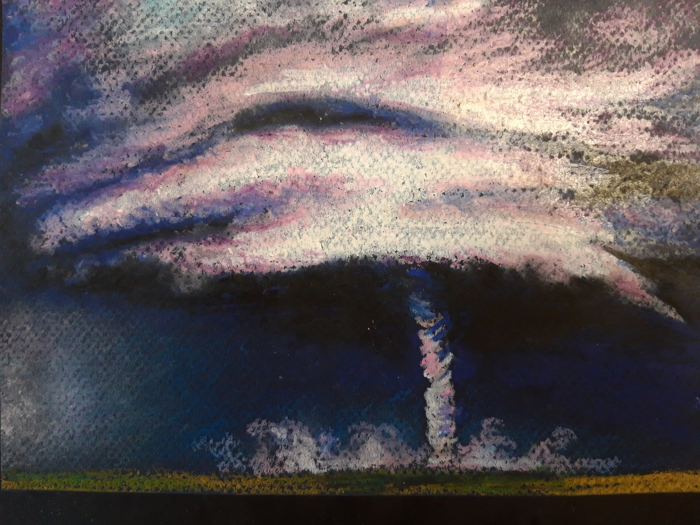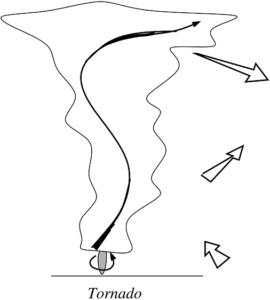Tornado
The tornado, star of apocalyptic Hollywoodian movies, is a devastating meteorological phenomenon.

Supercell storm with a tornado on the Great Plains of the United States of America, oil pastel by Camille Risi from a free of rights photograph, 2022.
Specific features
A tornado is a concentration of swirling ascending airstreams that opens a passageway between the ground and the bottom of a storm cloud. In a funnel shape (the tuba) with a diameter between 50 and 1 000 metres, it moves in zigzag and vacuum everything on its way. The winds are extremely strong, often above 100km/h. The strongest winds ever measured in a tornado were going at a speed of 484km/h, in Oklahoma.
Origin
 Tornadoes are typically found in supercell storms. The rotation movement is induced by changing winds with altitude. In the updrafts, this rotation inclines at a vertical angle. The wind speed in a tornado is such that the centrifugal force becomes important, like in a funnel. This is a similarity with cyclones, but in the case of the tornado, the Coriolis effect is insignificant at such a small spatial scale. Thus, in theory, tornadoes can turn in any direction. Yet, in the North hemisphere, 98% of tornadoes turn counter clockwise, which corresponds to the rotation direction of winds around supercells. The weak pressure inside the funnel makes water vapour condense into droplets, giving it its white aspect.
Tornadoes are typically found in supercell storms. The rotation movement is induced by changing winds with altitude. In the updrafts, this rotation inclines at a vertical angle. The wind speed in a tornado is such that the centrifugal force becomes important, like in a funnel. This is a similarity with cyclones, but in the case of the tornado, the Coriolis effect is insignificant at such a small spatial scale. Thus, in theory, tornadoes can turn in any direction. Yet, in the North hemisphere, 98% of tornadoes turn counter clockwise, which corresponds to the rotation direction of winds around supercells. The weak pressure inside the funnel makes water vapour condense into droplets, giving it its white aspect.
Evolution
Tornadoes, especially their winds, can generate huge damages. They kill between 300 and 400 persons each year throughout the world.
When to see it
The lifespan of a tornado is short and it rarely travels further than a few kilometers. They often form in the spring and summer in the Great Plains in the United States, in what is called Tornado Alley. They can also be created when cyclones reach solid ground.
Did you know?
In 2014, two Americans ornithologists, Henry Streby and David Andersen, made a surprising and accidental discovery. They had equipped with a GPS golden-winged warblers, a lovely species of small birds that migrates through the American continent. The researchers noticed they had taken a detour of a few hundred kilometers to Florida, avoiding with great luck the route of a tornado… Luck? Well, perhaps not. According to the scientists, it is likely these birds heard infrasound – sounds under 20Hz inaudible to the human ear – linked to the storm and decided to flee before the storm.






